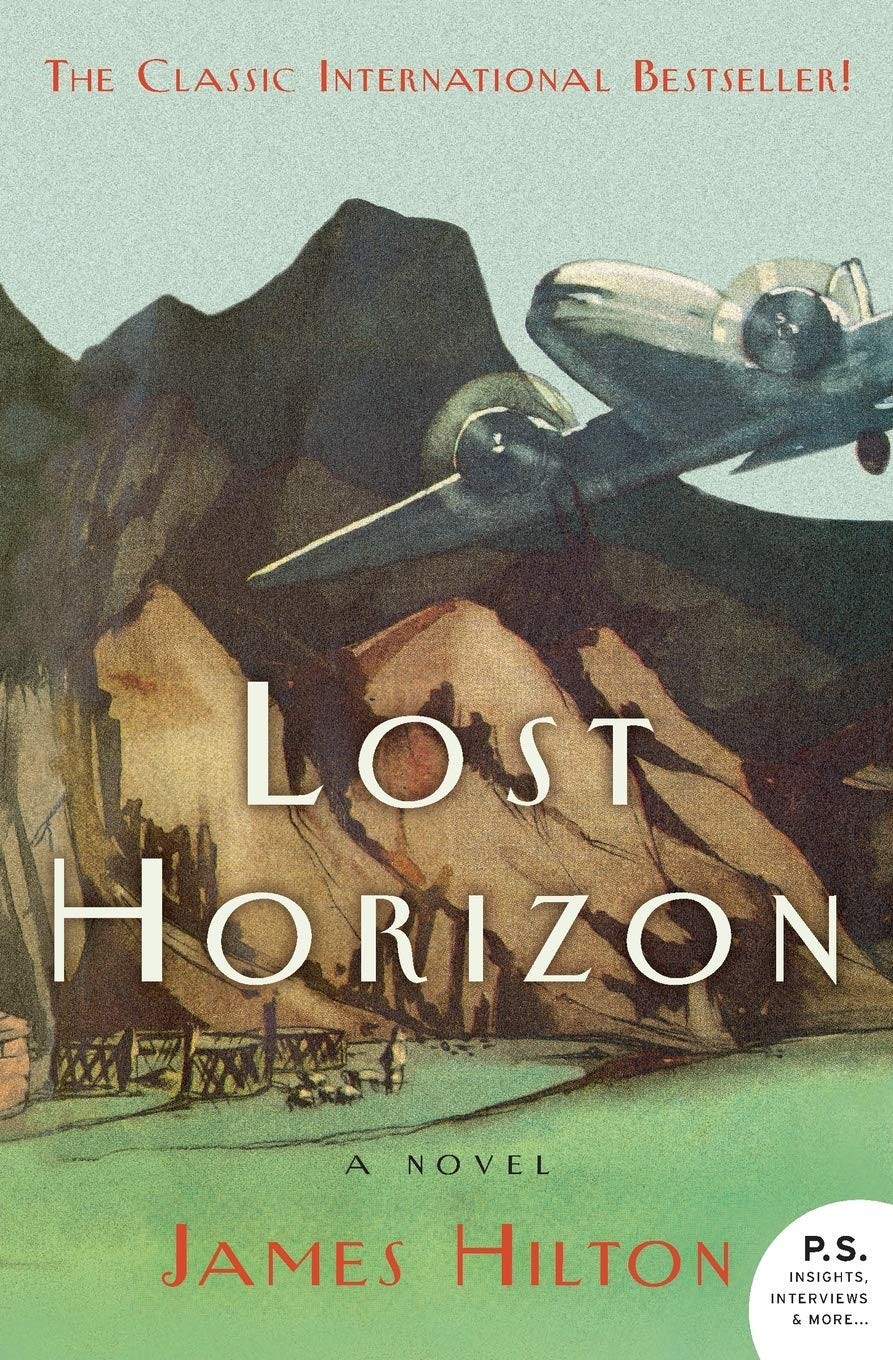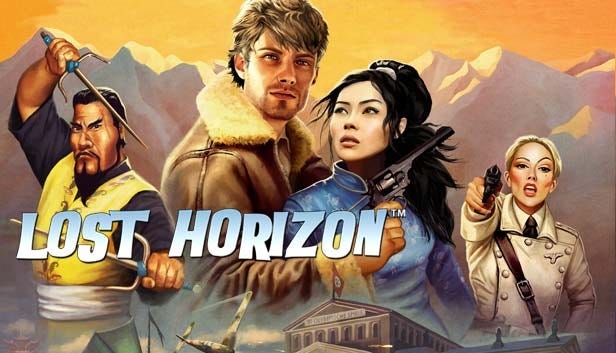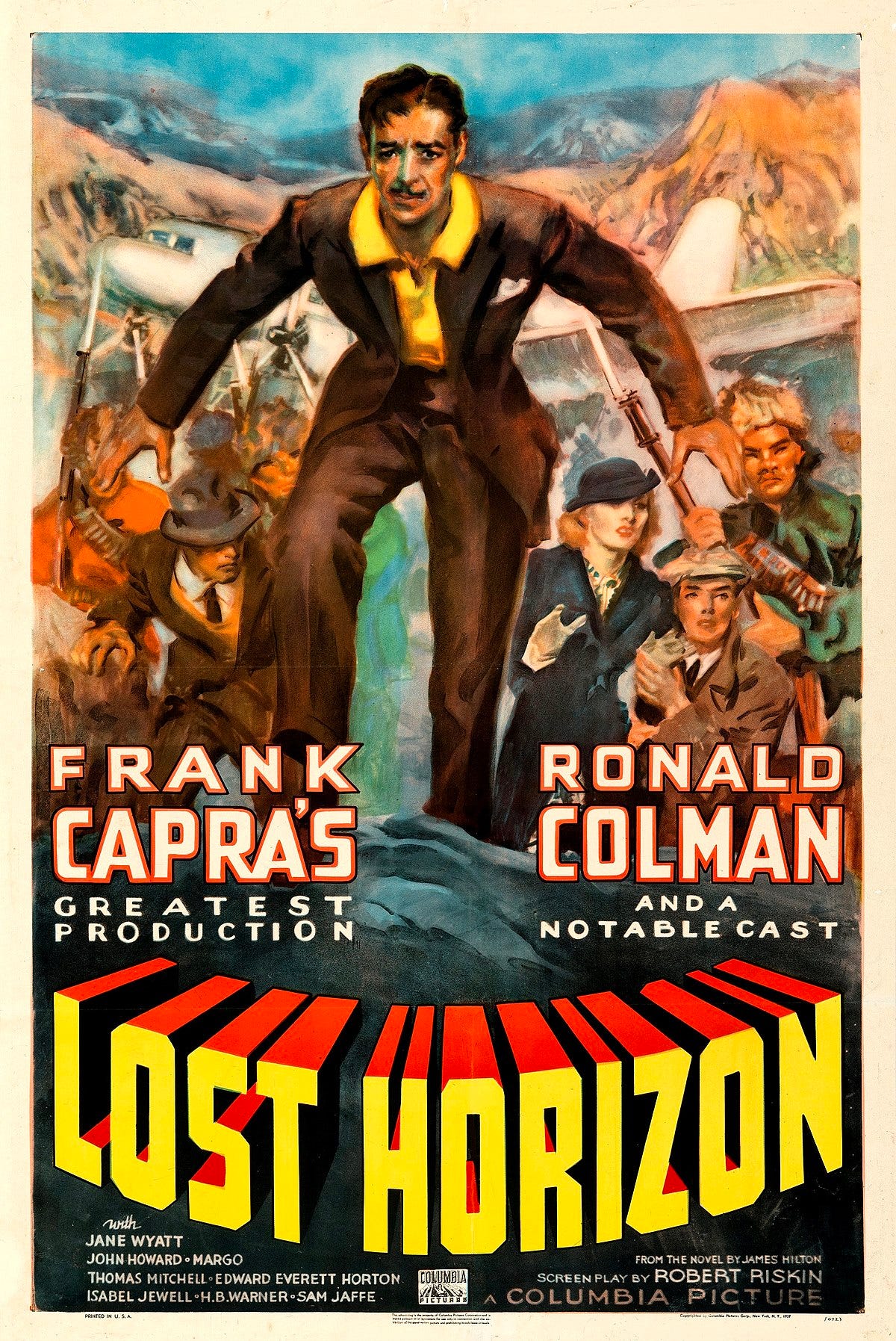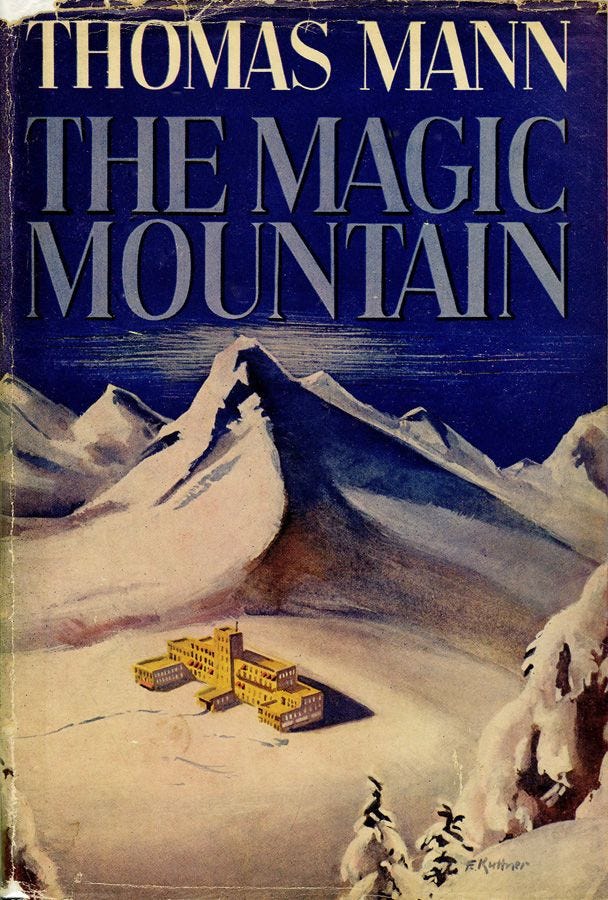THE PERFECT BOOK FOR COMING OUT OF QUARANTINE
Back in March and April of 2020, pandemic reading lists began to proliferate online. These usually included Camus’ The Plague, Da Foe’s A Journal of the Plague Year, Garcia Marquez’s Love in the Time of Cholera, Stephen King’s The Stand, Michael Crichton’s The Andromeda Strain, and Katherine Anne Porter’s Pale Horse, Pale Rider, to name but a few. One book I never saw listed was James Hilton’s 1933 pop-fiction classic Lost Horizon. But if you were putting together a Coming-Out-of Quarantine reading list you might want to put Hilton’s novel somewhere near the top.
Lost Horizon tells the story of four people – two British Foreign Service workers, a British Christian missionary, and an American financial swindler – who find themselves aboard a hijacked airplane. They boarded the plane in order to evacuate a town in Afghanistan that was under siege by rebels. Not until they are several hours into their flight do the passengers begin to realize that the pilot is not one of them (i.e., a Westerner) but rather a native of some nearby region, perhaps India or Tibet. They also realize that he is taking them deeper into the Orient rather than out of it. One of the passengers, Hugh Conway, opens a small window that separates the cabin from the cockpit and orders the pilot to change course. But the captain merely points a pistol in Conway’s direction and the British diplomat wisely backs down. Eventually the plane lands somewhere high in the Tibetan mountains and the four passengers make their way to a nearby lamasery called Shangri-La. When they arrive at the lamasery, they are greeted with open arms, as if they had been expected. They are given food and drink and accommodations featuring all the modern conveniences, including American flush toilets from Akron, Ohio.
So influential was Hilton’s novel that Shangri-La quickly entered the English language (and plenty of others) as a generic term describing any remote and idyllic hideaway, a term roughly synonymous with Utopia and Nirvana and Eden. He couldn’t have known it at the time he wrote it, but Hilton’s Shangri-La nowadays has eerie similarities to the internet. It is a place in which impossibly vast amounts of knowledge have been preserved and are available for anyone to draw upon at any time. Almost any book ever written can be accessed there. A complete archive of the London Times is available for inspection. Almost every worthwhile piece of music ever composed can be found there. If you want to learn a foreign language, you can find resources for doing just that in Shangri-La. Ditto, if you want to learn a musical instrument. You can communicate with great minds at Shangri-La and you can debate philosophy, religion, art, and any other topic endlessly with other likeminded people. Living at Shangri-La is like having access to every TED Talk and every TED Talk speaker at your fingertips at all times. Like many of today’s internet surfers, the intellectually curious of Shangri-La could find “many tideless channels in which they dived in mere waywardness, retrieving…fragments of old tunes, or…a new theory about Wuthering Heights.” Conway even refers to these people (admiringly) as “slackers.” He notes that Shangri-La is a great place to pursue “an infinitude of odd and apparently trivial employments.” Shangri-La is also a great place for the internet activity known as “catfishing.” Nobody needs to know your age in Shangri-La. You may be a wizened centenarian but, if you want to pass as a wrinkle-free 17-year-old, you can do so without anyone being the wiser. As with today’s always-online incels and pornography addicts, sex ceases to exist for those who live at Shangri-La except as a thing of the imagination. And, also like the internet, Shangri-La is a hard place to quit. It is a seemingly-infinite rabbit warren of fascinating facts and endless discussions. Those who dwell there soon lose their physical conditioning because their energies are focused on mental rather than physical exertion. Conway spends most of his time chatting about philosophy and music and other topics with the lamas. Of these chats, Hilton writes: “Their talks ranged far and fearlessly; entire philosophies were unfolded; the long avenues of history surrendered themselves for inspection and were given new plausibility.” In striking contrast with today’s internet, however, Hilton notes that the philosophers of Shangri-La “were all endowed with a calm intelligence which pleasantly overflowed into measured and well-balanced opinions.”
Our four main characters arrive at Shangri-La during a time of great turmoil in the outside world. The specter of another world war has begun to rear its ugly head. The Japanese are viciously bombing Shanghai and other Chinese population centers. The stock markets are in turmoil. Revolutionaries everywhere are rising up against the world order. But our four travelers from the west are safe from it all in Shangri-La. Their relatively easy and comfortable existence is made possible by the exertions of the Tibetans who live in the valley below. It is they who grow the food and bring it to Shangri-La. It is they who take the gold that is plentiful in Shangri-La and make arduous treks of thousands of miles in order to trade that gold for books, artworks, musical instruments, and all of the other things that make Shangri-La a relative paradise on earth.
When you read Lost Horizon in 2021 it is difficult not to think of those who live in Shangri-La as the equivalent of the lucky Americans and Brits who were able to work remotely from home via the internet during the worst of the pandemic. Likewise, it is difficult not to think of the toilers in the valley below Shangri-La as the essential workers who had to continue going off to work during the pandemic, even at the risk of their own health, in order to keep things running smoothly for the lucky few above. For the work-from-home crowd, the pandemic was mainly something that happened to other people. For essential workers it was the stuff of everyday hardship.
But there is another way in which Lost Horizon reflects our current cultural moment. Just as we have been engaged for months in a debate about when it will be safe to lift various lockdown orders and return to ordinary life, the two main characters in Lost Horizon – Conway and Mallinson, the British consulate workers – spend much of the book debating when (and even whether) they should leave Shangri-La. Mallinson, the younger of the two, wants to leave right away, despite the various dangers this might create for them and for others. Conway, the older of the two and the more cautious, wants to wait. Not only is he not eager to begin the arduous journey back to normalcy, but he also finds that he kind of likes the new normal, he likes living and “working” in the comfort of Shangri-La (his work consists mainly of chatting with the lamas). Their arguments sound like the recent debates between cautious liberals who want to reopen the country only gradually and conservatives who want to end all the lockdowns and reopen all the schools and restaurants and bars immediately. Tired of the argument, Mallinson tells Conway, “Look here, Conway, it’s got on your nerves, this place, and I really don’t wonder at it. Pack up your things and let’s quit. We’ll finish this argument a month or two hence, after a jolly little dinner at Maiden’s.”
“I’ve no desire to go back to that life at all,” Conway responds.
“What life?” asks Mallinson.
“The life you’re thinking of…dinners…dances…polo…and all that…”
And then the debate, as such debates often do, devolves into name calling, as Mallinson tells Conway, “You’re off your head! You’re mad, Conway, that’s what’s the matter with you! I know you’re always calm and I’m always excited, but I’m sane, at any rate, and you’re not!”
Conway concedes that some of his objections to leaving Shangri-La may not be sound. He tells Mallinson, “I suppose the truth is that when it comes to believing things without actual evidence, we all incline to what we find most attractive.” And so, finally, he agrees with Mallinson that the time has come to end the lockdown, to leave Shangri-La and return to normal life.
And what do they find there? About what you’d expect – war, sickness, death, sorrow, corruption, and various other evils. The same things we confront in ordinary life. Lockdowns can’t protect us from them forever. Even the privileged and powerful aren’t fully immune from those ills. Our task in this world, as the High Lama explains to Conway, is, “To be gentle and patient, to care for the riches of the mind, to preside in wisdom and secrecy while the storm rages without…”
In writing his pop-fiction masterpiece, Hilton might have been influenced by an even greater masterpiece, Thomas Mann’s The Magic Mountain, the first English-language translation of which was published just a few years earlier in 1927. Both novels are about people who live in a sort of retreat high up on a mountain, far away from the cares of the world below. Mann’s main character is Hans Castorp. Hilton’s main character, Hugh Conway, also has a one-syllable first name that begins with an H, and a two-syllable last name that begins with a C. The first American editions of the two books bore startlingly similar cover illustrations. In the end, the protagonists of both novels leave behind the safety of their alpine paradise and emerge into a world of chaos and hostility, a world that seems certain to destroy them. Mann aimed his novel at the intelligentsia. Hilton aimed his at the masses. Both were right on target.
Lost Horizon was published in 1933 but the events it describes begin in May of 1931, which means that May of 2021 marks the ninetieth anniversary of the discovery of Shangri-La by Conway and the others. Two of the party remained in Shangri-La, the crook and the Christian. And, for all we know, they remain there still, ever youthful, ever in lockdown. It’s up to you, the reader, to decide if they made a wiser choice than did Conway and Mallinson. Ultimately it is up to all of us, individually, to decide when it is best to come out of lockdown.








